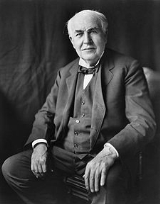
, the motion picture camera
, and a long-lasting, practical electric light bulb. In addition, he created the world’s first industrial research laboratory. Dubbed "The Wizard of Menlo Park" (now Edison, New Jersey
) by a newspaper reporter, he was one of the first inventors to apply the principles of mass production
and large teamwork to the process of invention, and therefore is often credited with the creation of the first industrial research laboratory.
Edison is the fourth most prolific inventor in history, holding 1,093 US patents in his name, as well as many patents in the United Kingdom, France, and Germany.
1869 Thomas Edison receives a patent for his electric voting machine.
1876 Thomas Edison receives a patent for his mimeograph.
1877 Thomas Edison announces his invention of the phonograph, a machine that can record and play sound.
1877 Thomas Edison demonstrates his phonograph for the first time.
1877 Thomas Edison, first human voice recorded, {Mary had a little lamb.}
1878 Thomas Edison patents the phonograph.
1879 Using a filament of carbonized thread, Thomas Edison tests the first practical electric incandescent light bulb (it lasted 13½ hours before burning out).
1879 Thomas Edison demonstrates incandescent lighting to the public for the first time.
1880 Thomas Edison observes the Edison effect.
1880 In Menlo Park, New Jersey, Thomas Edison performs the first test of his electric railway.

